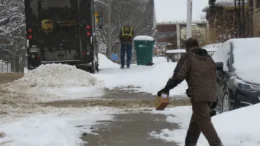Rain barrels are the final piece of the puzzle in dealing with stormwater on your property—they capture the rain and store it for later use on-site. In addition to permeable surfaces, plants that tolerate large volumes of water, healthy lawns to enhance absorption, and rain gardens, rain barrels are a simple and effective way to handle water that would normally run off into stormwater systems.
Harvesting the water from a nice heavy rain allows you to water plants deeply, optimizing their health and vigor.
Rain barrels range in capacity from 30 to 100 gallons. A rough determination of capacity for your site involves measuring the surface area of the roof draining into the downspout inserted into the barrel, as well as calculating the volume of rain per event in inches. For example, a surface area of 1000 square feet receiving half an inch of rain would result in 300 gallons of water to be captured in rain barrels. A good-sized rain barrel, or series of rain barrels, would allow you to capture a substantial portion of that water.
Look for a rain barrel that has the following features:
- Is child and animal proof, with a lid that can’t be easily removed Has a mesh screen to filter out debris, whether on top of the rain barrel or attached to the downspout.
- An overflow valve connected to a hose in order to allow water from a fully filled barrel to flow away from your house. Another option is to purchase a diverter to install on the downspout. Diverters allow water to fill the barrel, and once full returns the flow back into the downspout.
- For ease of use, an elevated stand for the barrel to sit on. This allows easy access to a spigot at the base of the barrel. Stands must be sturdy enough to withstand the weight of a full rain barrel.
- If you have room to add another barrel eventually, look for one that allows the barrel to connect to another in series.
Water collected in rain barrels can be used to water ornamental plants. The outlet hose can be attached to soaker hoses or by filling watering cans. While the water collected in a rain barrel does not have the chlorine contained in municipal water systems, it does pick up contaminants from roofing materials. Therefore, it is not considered potable—do not drink or cook with rain barrel water. A good overview of using rain barrel water on edible crops can be found via Rutgers University Cooperative Extension.
Rain barrels should be emptied during winter months, and either brought indoors or covered so as not to allow any water to enter the barrel when temperatures are below freezing.
This educational blog is a series of informative articles from the Penn State Master Gardeners volunteers plus news concerning the group and their activities. For more information, click here.





































